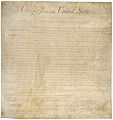First Amendment to the United States Constitution facts for kids
The First Amendment is a very important part of the United States Constitution. It's like a shield that protects some of your most basic rights. This amendment is part of the United States Bill of Rights. It makes sure you have freedom of speech, freedom of religion, freedom of assembly, freedom of the press, and the right to petition the government. These freedoms help make sure everyone can share their ideas and beliefs.
Congress shall make no law respecting an establishment of religion, or prohibiting the free exercise thereof; or abridging the freedom of speech, or of the press; or the right of the people peaceably to assemble, and to petition the Government for a redress of grievances..
Contents
Your Freedoms
The First Amendment gives you five main freedoms. These are:
Freedom of Religion
This freedom has two main parts. First, the Establishment Clause means the government cannot create an official religion for the country. It also cannot favor one religion over others. This idea is often called "separation of church and state". It means the government should not tell people what to believe.
Second, the Free Exercise Clause means you are free to practice any religion you choose. You can also choose not to practice any religion at all. The government cannot stop you from following your beliefs.
Freedom of Speech
This freedom means you can share your thoughts and ideas without the government stopping you. You can speak, write, or express yourself in many ways. This includes what you say online, in school, or in public. However, this freedom does not protect speech that causes harm, like yelling "fire!" in a crowded theater when there is no fire.
Freedom of the Press
This freedom means that newspapers, magazines, TV, radio, and online news sources can report the news without the government telling them what to say. It allows journalists to share information, even if it criticizes the government. This helps keep the public informed.
Freedom of Assembly
This freedom means people can gather peacefully in groups. You can join protests, meetings, or clubs. You can meet with others to share ideas or to ask the government to make changes. This right allows people to come together for common causes.
Right to Petition
This freedom means you can ask the government to fix problems or change things. You can write letters, sign petitions, or contact your elected officials. It allows you to tell the government what you think and ask them to listen to your concerns.
Why These Freedoms Matter
These five freedoms are very important for a country where people govern themselves. They allow citizens to speak up, share ideas, and work together for a better society. They help make sure the government listens to its people and respects their rights.
Related pages
Images for kids
-
The Bill of Rights in the National Archives.
-
George Mason was the principal author of the Virginia Declaration of Rights, adopted by the Fifth Virginia Convention on June 12, 1776.
-
James Madison, drafter of the Bill of Rights.
-
The Maryland Toleration Act secured religious liberty in the English colony of Maryland. Similar laws were passed in Rhode Island, Connecticut and Pennsylvania. These laws stood in direct contrast with the Puritan theocratic rule in the Plymouth and Massachusetts Bay colonies.
-
Thomas Jefferson's tombstone. The inscription, as he stipulated, reads "Here was buried Thomas Jefferson, author of the Declaration of American Independence, of the Statute of Virginia for Religious Freedom, and father of the University of Virginia."
-
An April 22, 1885, cartoon from the Puck magazine depicting an army of clergymen assaulting a fortress defended by newspaper editors including from Puck, while atop a hill in the background a statue labeled "Constitution" that states "Congress shall make no law respecting an establishment of religion" can be seen.
-
The Founding of Maryland (1634) depicts Father Andrew White, a Jesuit missionary in the left and colonists meeting the people of the Yaocomico branch of the Piscatawy Indian Nation in St. Mary's City, Maryland, the site of Maryland's first colonial settlement.
-
President Thomas Jefferson wrote in 1802 of "a wall of separation".
-
The First Church of Christ, Scientist in Boston, Massachusetts.
-
Bear Butte, in South Dakota, is a sacred site for over 30 Plains tribes.
-
Washington National Cathedral, the Episcopal cathedral in Washington, D.C.
-
The U.S. guarantees freedom of religion, and some churches in the U.S. take strong stances on political subjects.
-
Inscription of the First Amendment (December 15, 1791) in front of Independence Hall in Philadelphia.
-
Justice William J. Brennan, Jr. wrote the landmark decision New York Times Co. v. Sullivan, requiring the demonstration of "actual malice" in libel suits against public figures.
-
The Newseum's depiction of the five freedoms guaranteed by the First Amendment to the US Constitution in Washington, D.C.
-
The leak of the Pentagon Papers by Daniel Ellsberg (pictured here in 2018) led to New York Times Co. v. United States (1971), a landmark press freedom decision.
-
Chief Justice Morrison Waite ruled in United States v. Cruikshank (1875) that the right of assembly was a secondary right to the right to petition.
See also
 In Spanish: Primera Enmienda a la Constitución de los Estados Unidos para niños
In Spanish: Primera Enmienda a la Constitución de los Estados Unidos para niños

















